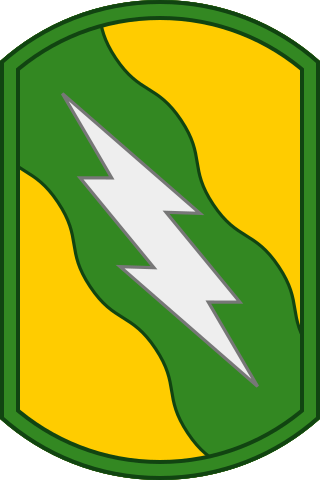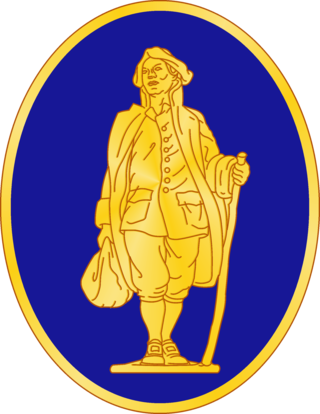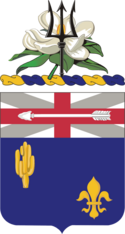
The 31st Infantry Division ("Dixie") was an infantry division of the United States Army National Guard, active almost continuously from 1917 to 1968. Composed of men from Alabama, Florida, Georgia, Louisiana, Michigan, Illinois, and Mississippi at various points in its existence, the division saw service in both World War I and World War II, and was mobilized during the Korean War, although it was not sent overseas in the latter.
The Mississippi Army National Guard is the Army National Guard component of the Mississippi National Guard. It was originally formed in 1798. It is a component of the United States Army and the National Guard. It is managed by the Mississippi Military Department.

The 142nd Field Artillery Regiment is a United States Army field artillery regiment currently represented in the Arkansas Army National Guard by the 1st Battalion, 142nd Field Artillery, headquartered in Bentonville, Arkansas; 2nd Battalion, 142nd Field Artillery, headquartered in Barling, Arkansas; and Battery F, 142nd Field Artillery stationed in Fayetteville, Arkansas, elements of the 142nd Field Artillery Brigade which is headquartered in Fayetteville, Arkansas. The regiment was created in 1917 from the former 2nd Arkansas Infantry. The 142nd Field Artillery shipped to France during World War I but did not see combat before the cessation of hostilities. The regiment was activated for World War II, but its battalions were redesignated as separate battalions, 1–142nd became the 936th Field Artillery Battalion, the 2–142nd became the 937th Field Artillery Battalion. The battalion's served throughout the European Theater of Operations. The battalions were activated again for the Korean War and served throughout the war. Following the Korean War, the separate battalions resumed their former designations of 1–142nd FA and 2–142nd FA. The 142nd Field Artillery Brigade, including both battalions, was activated for Operation Desert Storm. Elements of the 142nd Fires Brigade have been activated for service in Operation Noble Eagle and Operation Iraqi Freedom. The 142nd Fires Brigade was instrumental in support and recovery operations located in New Orleans, Louisiana after hurricanes Katrina and Rita devastated the Gulf Coast.

The 39th Infantry Division was an infantry formation of the Army National Guard, originally formed as the 18th Division in 1917. The division consisted of troops from Arkansas, Louisiana, and Mississippi. After training at Camp Beauregard, Louisiana, the division was deployed to France but did not see combat before the end of World War I. In July 1923 the division was re-designated as the 31st Infantry Division. The 39th Infantry Division was reactivated after World War II with troops from Louisiana and Arkansas and its headquarters in Louisiana. In 1967, the 39th Infantry Division was reorganized to become the 39th Infantry Brigade (Separate). Its headquarters was in Little Rock and the unit consisted entirely of troops from Arkansas.

The 108th Cavalry Regiment is a cavalry regiment of the Georgia and Louisiana Army National Guards of the United States Army.

The 156th Infantry Regiment is an infantry regiment in the United States Army and the Louisiana National Guard. It began as a Confederate Army unit in 1861, and surrendered to the Union at the Battle of Appomattox Court House in 1865. It was reformed in 1878 as a militia unit, and reorganized into the Louisiana National Guard in 1899. It saw support service in World War I. In world War II it served as a guard battalion in Europe, for which it added a lion to its coat of arms to symbolize its service in northern France. It deployed twice during the Iraq war.
The 141st Infantry Regiment is an infantry regiment in the United States Army. The lineage of the 141st includes units tracing origins to the Texas Revolution, such as Company A, First Texas, 1836, and other infantry companies of the First Texas formed in the 1870s and 1880s.

The 206th Field Artillery Regiment is a United States artillery regiment, currently represented in the Arkansas Army National Guard by the 1st Battalion, 206th Field Artillery, Headquartered at Russellville, Arkansas. The 1–206th FA is an element of the 39th Infantry Brigade Combat Team.

The 153d Infantry Regiment is a United States infantry regiment, currently represented in the Arkansas Army National Guard by the 1st Battalion, 153rd Infantry, headquartered at Malvern, Arkansas, and 2nd Battalion, 153rd Infantry, headquartered at Searcy, Arkansas, elements of the 39th Brigade Combat Team. The regiment was also represented by the 3rd Battalion, 153rd Infantry Regiment headquartered at Warren, Arkansas until that unit was deactivated on 5 September 2005. The regiment was activated as the 1st Arkansas Volunteer Infantry for the Spanish–American War, but did not deploy overseas. The regiment was activated for World War I, redesignated as the 153rd Infantry and shipped to France as a part of the 39th Division, but became a replacement division and personnel were reassigned to other AEF units. The regiment was activated for World War II and deployed to the Aleutian Islands, participating in the Aleutian Islands Campaign. Recently, elements of the regiment have participated in two deployments in support of Operation Iraqi Freedom, in 2004 and again in 2008.

The 155th Armored Brigade Combat Team is a brigade combat team of the Mississippi Army National Guard.

The 111th Infantry Regiment, originally the Pennsylvania Militia or "Associators", were a Pennsylvania militia unit that fought in the American Revolution, composed of civilian males from the citizenry of Pennsylvania. It is one of several National Guard units with colonial roots and campaign credit for the War of 1812. The Pennsylvania Militia often fought in conjunction with General Washington and the Continental Army along the Delaware River.

The history of the Arkansas National Guard and World War I begins with the reorganization of the Arkansas State Guard following the Spanish–American War. As a result of difficulties encountered during the mobilization of state militia forces, the United States Congress passed new legislation which resulted in the renaming of the Arkansas State Guard as the Arkansas National Guard. The new federal legislation resulted in increased funding and training for the guard. The newly reorganized Arkansas National Guard was call upon by the President to help defend the border with Mexico in 1916 in response to cross border raids during the Mexican Revolution. The Arkansas National Guard had just returned from the Mexican Expedition in 1917 when it was activated for World War I. As a part of their incorporation in the United States Army, all National Guard units were renumbered in accordance with a federal system. The Arkansas National Guard units were incorporated into the 39th Infantry Division and after training at Camp Beauregard, were shipped to France in August and September 1918. The 39th Division was broken up, with some units being used as replacements for other divisions. Most former Arkansas National Guardsmen returned to the United States in February through June 1919 and were demobilized.

The 124th Infantry Regiment is a parent regiment of the United States Army, represented in the Florida Army National Guard by the 1st Battalion headquartered in Miramar and 2nd Battalion at Orlando. The two Battalions are elements of the 53rd Infantry Brigade Combat Team.

The 133rd Field Artillery Regiment is a parent field artillery regiment of the United States Army National Guard. It is currently represented in the Texas Army National Guard by the 1st, 3rd, and 4th Battalions.

The 181st Infantry Regiment shares the distinction of being the oldest combat regiment currently organized in the United States Army. It is one of several National Guard units with colonial roots and campaign credit for the War of 1812. The regiment traces its history to 13 December 1636, when it was one of four colonial regiments of foot of the British Crown in Massachusetts. It later served in the Continental Army during the American Revolution, with Union forces in the American Civil War, and as a federalized Massachusetts National Guard regiment with the U.S. Army during War with Spain, Mexican Border Campaign, World War I, and World War II. In 2006 Company A (Agawam) of the battalion deployed as a member of KFOR8 to Kosovo in support of Operation Joint Enterprise. Most recently the 1st Battalion, 181st Infantry has served in Iraq, in New Orleans following Hurricane Katrina, and in Afghanistan. The only active element of the regiment is the 1st Battalion, 181st Infantry Regiment, which returned from a year of service in Afghanistan in July 2011. The 1st Battalion was mobilized in March 2017 for one year of service with the Multinational Force & Observers in the Sinai Peninsula of Egypt. Currently, the 1st Battalion is a part of the 44th Infantry Brigade Combat Team, a major formation of the New Jersey National Guard. It was reflagged from the 50th Infantry Brigade Combat Team in 2017.
The 154th Regiment (Regional Training Institute) ("Third Arkansas") is a training regiment/institute of the Army National Guard. Most of its history before the 1990s can be traced to the 154th Infantry Regiment which was created from the 1st and 2nd Battalions of the 3rd Arkansas Infantry Regiment, Arkansas National Guard, in 1917. The Regiment was activated as for World War I, re-designated as the 154th Infantry and shipped to France as a part of the 39th Infantry Division, but became a replacement regiment and its personnel were reassigned to other American Expeditionary Force (AEF) units.

The 133rd Infantry Regiment is an infantry regiment in the Iowa Army National Guard. It is represented by the 1st Battalion, 133rd Infantry Regiment, part of the 2nd Infantry Brigade Combat Team, 34th Infantry Division.

The 134th Cavalry Regiment is a cavalry regiment in the Nebraska Army National Guard. By extension, it is a member of the United States Army National Guard, and as a currently federally-recognized unit, also a member of the National Guard of the United States.
The 138th Infantry Regiment is a light infantry regiment of the United States Army and the Missouri National Guard.
The 114th Field Artillery Regiment is a field artillery regiment of the Mississippi Army National Guard. The regiment's 2nd Battalion is the cannon battalion assigned to the 155th Armored Brigade Combat Team.

















